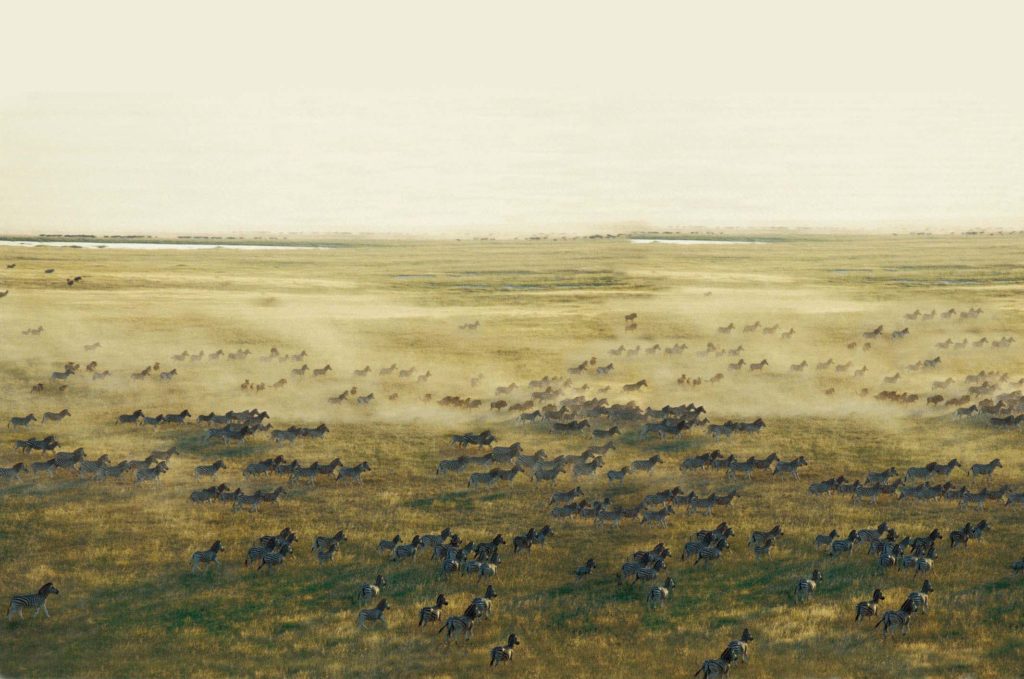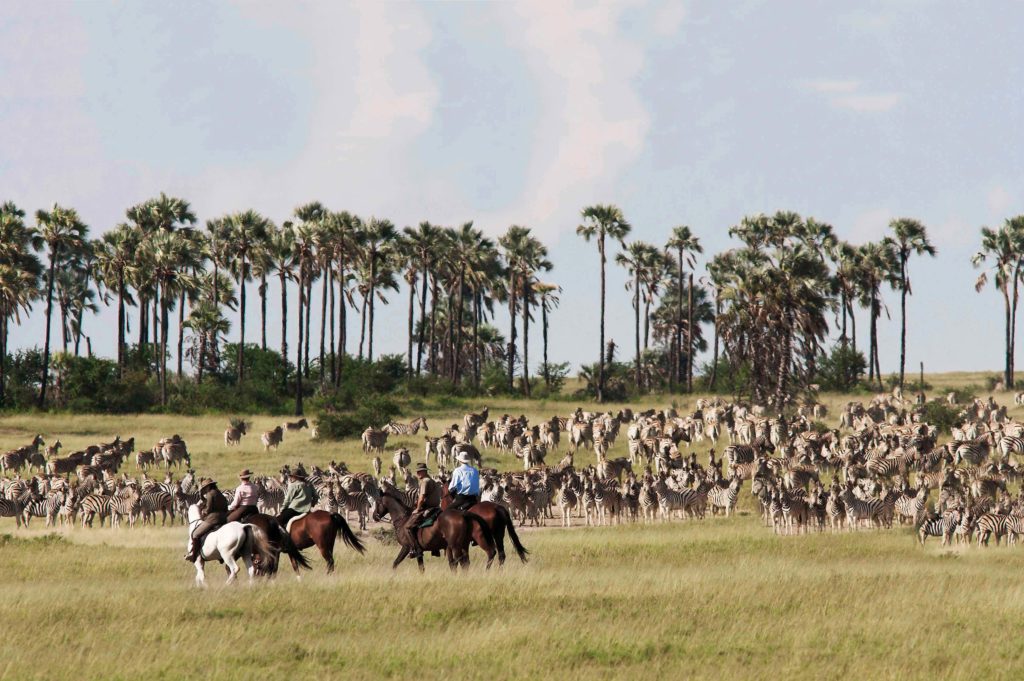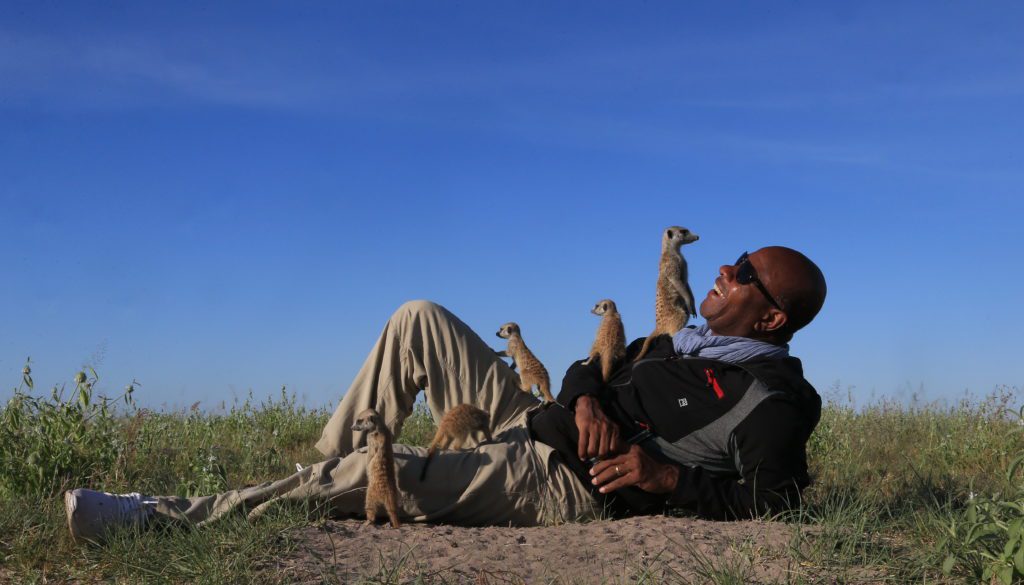A Humorous Chronicle of Botswana’s Great Zebra Migration
By Peter Allison, for Extraordinary Journeys

The Mysterious Migration of the Makgadikgadi, In recent years, whispers have grown about a wildlife phenomenon in Botswana. Every year tens of thousands of zebras have been gathering in the Makgadikgadi Pans, the largest network of salt pans in the world. Where are they coming from? Why had no one noticed before? Do you rhyme it with Debra or D-Bra?
Like all stories, it is best to start at the start. This story begins as we do, on the shores of the largest lake Africa has ever known. Paleontologists call it Lake Makgadikgadi, and if we could travel back to see it many familiar species would be there. Hippos, giraffes, elephants, the stars of this story the zebras in large numbers, and a new, upstart ape was living on its banks. This species should look very familiar to us, as they were the very first Homo Sapiens, probably looking at the crocodiles in the water and lions on land and wishing we’d evolved somewhere more hospitable.
Over millennia the lake dried up leaving a network of saline pans, Homo Sapiens moved on, made a mess in most places, but broadly ignored the vast dryland that had once been home. If we fast forward to 1967, the newly independent nation of Botswana had been granted self-rule but entered the world stage one of the poorest nations per capita on the planet. European countries agreed to buy beef at a fair-ish price, but only if Botswana could guarantee that the cattle did not carry foot-and-mouth disease. To prevent this, a series of fences were erected to exclude wildlife and livestock from mingling.
It seemed a reasonable idea. Tourism barely existed in Africa beyond a few playing out their great hunter fantasies. The idea of coming to enjoy a spectacle for its own breathtaking sake was not on anyone’s radar, and if it was, they would go to the famed migration of the Serengeti and Masai Mara. So, it was little reported on that there was another great migration, nor that the fences killed it. Until then, for millennia, every year as the rains came a few weeks before Christmas, wildebeest would swarm into the Pans from the surrounding Kalahari, and zebras would arrive en masse as well. Various other species joined the fray, springbok, hartebeest, even rhinos would come for the rich grass that would spring up. An area that is stark white in winter is brought to life by water, and all the nutrients from what was once a lake floor make a feast for herbivores. But in 1967, with no access to the region due to the fences, millions of animals died, piled up against chainlink or staggering back to an area they’d left because it wasn’t sustainable to stay, where they starved.

If we fast forward again to the beginning of this century, Botswana now had a burgeoning tourism sector, in fact it had finally overtaken beef in terms of economic importance and certainly in numbers of people employed (it is worth noting that soon after the fences went up, diamonds were discovered, and in such numbers that Botswana had one of the fastest growing economies in the world for a full decade and a half). In the early 2000s it was decided to remove the fences. There was no expectation of some wizened and wise zebra though that would lead the ancient way. They live a mere 12 years or so in the wild, and those memories would be long gone.
Yet the Pans started filling not just with grass, but zebras. This was a mystery. Scientists grew bored of scratching their heads and decided to collar some to see where they were coming from. Led by the most Englishly-named person in the world, Dr. Hattie Bartlam-Brooks, they discovered this was nothing like the east African swirl of animals, a constant carnival of movement, but at least three different migrations. A further difference is that these animals all gathered for summer in one place before heading to their winter homes, like Minnesotans and New Yorkers meeting in Florida ever year. Many would leave their summer grounds near the famous Jack’s Camp (also home at that time of year to half a million flamingos, give or take a dozen or so) and head to the Boteti River, the nearest permanent source of water and winter grazing. From May they arrive here, their whooping whistles making a winter soundtrack at Meno a Kwena, which sits on a river-carved cliff overlooking one of their favourite drinking spots.

Other zebras have stronger urges to travel, and would carry on beyond the Boteti to the famed Okavango Delta just in time for its winter flood, spend a few months, then complete the return journey. These aren’t the zebra equivalent of gym junkies though, that title goes to a splinter group that travel even further. In fact, the satellite tracking has shown it to be the longest migration by foot recorded in Africa. Leaving the Makgadikgadi in March, they walk all the way to the Chobe River, as far north as you can get and still be in Botswana. Many in fact do cross over to the cattle lands of Namibia on the other side, grazing there until they get their first whiff of rain and start the long trip south once again, just as their ancestors did.

Further research, co-funded by Natural Selection as part of their commitment to local conservation, is revealing more possible pathways that the zebras take. Working with the communities along these routes has given the zebras free passage, and their numbers are rising, perhaps exponentially. In a world of bad news about wildlife, there is a bright light – it is entirely reasonable to believe that within our lifetimes Botswana will have not just the longest migration on the continent, but the largest.
Until then at least two mysteries remain. The first we think has been cracked. As the zebra numbers in the Makgadikgadi increased, so did the population of lions. Not a surprise that, but baffling was that meerkats numbers shot up as well. These group-living mongooses are a staple attraction of the Pans, and having greater numbers is most welcomed by safari guides and tourists alike, even if there was an awkward unknown as to why they were now everywhere.

The next mystery is how these zebras knew their way. As mentioned, it isn’t a living memory. Were stories passed generation to generation in some equine language we don’t understand? Or is a sense of home buried in their DNA? Our guests to the Pans often speak of a strange sense of belonging, something they’ve never felt elsewhere in the world, so maybe we too carry a genetic memory of where we are from. Khaki-clad safari guides and serious scientists find such an airy-fairy seeming concept a little itchy, but for now the romantic notion of a love and yearning for our original home is the best idea we have.
As to the meerkats, we have a theory, but will only tell it to you when you visit, and your boots are on the ground in the vast open spaces of Botswana. Come home.
Peter Allison is a safari guide and celebrated author who has spent much of his adult life leading wildlife-viewing and ecotourism trips in Africa, mostly Botswana. Born and raised in Sydney, Australia, he has a self-deprecating sense of humor that makes him an ideal narrator for his books, many of which detail the challenges and elusive joys of dealing with tourists in the African bush. His love of animals led him to train as a safari guide in the early 1990s, and soon thereafter he was hired by southern Africa’s largest operator to train all of their safari experts. Safaris he has led have been featured in magazines such as Vogue and Conde Nast Traveler (which described him as “silver tongued”). He has assisted National Geographic photographers and appeared on television shows such as Jack Hanna’s Animal Adventures.
